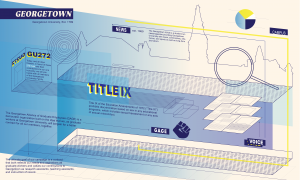After years of menstrual equity advocacy from student groups such as Hoyas for Choice (HFC), the Period Empowerment Project (PEP), and GUSA, Georgetown will expand free access to menstrual products in campus buildings.
Student advocates are working with facilities to ensure menstrual products in 85 percent of campus buildings, with items available in women and gender-neutral bathrooms, as well as in one clearly marked men’s bathroom in every academic building. According to a Sept. 5 GUSA press conference, Georgetown has made verbal commitments for increased access to menstrual products in on-campus bathrooms.
Jess Shannon (SFS ’23) and Keerat Singh (SFS ’23) are the current leaders of HFC’s menstrual equity campaign. In addition to co-coordinating the campaign, Shannon works with GUSA in Student Inclusion and Advocacy.
Shannon explained that the recent victory comes after years of student work with the university. Up to now, access to menstrual products on campus has been limited, with dispensers available in only 44 on-campus bathrooms. In order to increase access to products, PEP, HFC, GUSA, and Interhall have worked on a number of student-led initiatives to improve product availability.
“It has something that has been in process for a very long time. When I entered Hoyas for Choice as a freshman, it was already being worked on,” Shannon said. “It might have been easier if we combined efforts earlier, I think it is really great we are getting it done now.”
While administrators have asserted in the past that costs for menstrual products should remain the burden of students, the new initiative is funded through the university’s facilities department. Bathrooms with dispensers will continue to be stocked approximately four times a month by the university’s contracted companies, but additional baskets of products will be available in the bathrooms of most academic buildings and will be restocked by facilities staff as necessary. Bathrooms will be marked by a sticker to identify they contain menstrual products.
Shannon credits the recent commitments by the university to the success of students across campus organizations coming together in their efforts for on-campus menstrual equity.
“GUSA had menstrual equity programs going on, Period Empowerment Project was working on some as well, and Interhall was also working on menstrual equity,” Shannon said. “There were different tracks of menstrual projects happening.”
According to Shannon, HFC and GUSA hope to eventually expand the products to more buildings on campus. The current initiative still leaves some academic buildings, Yates, and residence halls without additional menstrual resources.
For members of HFC, ensuring that menstrual equity applies to men’s restrooms is a priority. While male and female bathrooms are traditionally seen as separating the population of menstruating and non-menstruating individuals, Shannon argued that such a system is unnecessarily binary, and excludes male-identifying menstruators from access to products.
“Not everyone who is a woman menstruates, and not everyone who is a man doesn’t menstruate,” Shannon said. “Some people with uteruses are men, and some people without uteruses are women.”
Under the new initiative, academic buildings stocked with menstrual products will have one men’s restroom with products. In addition to gender-neutral and women’s restrooms, Shannon hopes that one day all men’s restrooms on campus have access to similar resources.
“We want a men’s bathroom in each academic building, but we also want to work on expanding that to more men’s bathrooms, so that eventually all public bathrooms will have menstrual products in them.”





